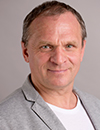08:00 | Conference Registration, Materials Pick-Up, Morning Coffee and Tea |
|
Session Title: Conference Opening Session -- Bioengineering to Build MPS 2022 |
| |
09:00 |  | Conference Chair Building a Human Body on a Chip: An Ongoing Journey 1989-20?? — A 33-year Odyssey
Michael Shuler, Samuel B. Eckert Professor of Engineering, Cornell University, President Hesperos, Inc., United States of America
A physiologically representative, multiorgan microphysiological system (or MPS) based on human tissues may become a transformative technology to improve selection of drug candidates most likely to earn regulatory approval from clinical trials. Also, such systems can be used to test cosmetics, food ingredients, and chemicals for potential toxicity. In this talk we will explore the history of the development one type of MPS known as a "Body-on-a-Chip" as well as current and future elaborations of this technology. Current "Body-on-a-Chip" systems combine organized tissue/organ mimics with the techniques of microfabrication based on PBPK (Physiologically Based Pharmacokinetic) models. Currently these systems are "self-contained" and do require external pumps, leading to "pumpless systems" which eliminates the need for an external pump, reduces system cost and improves operational reliability. While the fluid (or blood surrogate) in these systems can be sampled directly to allow measurement of concentrations of drug, metabolites or biomarkers, they can also be interrogated in situ to determine functional responses such as electrical response, force generation, or barrier integrity. The blood surrogate can be made to be as a serum-free, chemically defined medium facilitating interpretations of responses that are more mechanistic than with serum containing media. A key advantage of this approach is that we can predict both human efficacy and toxicity of a drug or drug combination in preclinical trails, A Hesperos system has been used as the sole source of efficacy data for an IND application by Sanofi for a drug currently in a Phase 2 clinical trial and data from an Emulate system has also been used to support an IND. For these systems to fulfill their real potential in drug development such use of these systems must become routine. Further there are questions on human toxicity of cosmetics and other chemicals, particularly mixtures, that can be addressed with such systems. |
|
09:45 |  | Conference Chair Nervous System-on-a-Chip: Closing the Knowledge Gap Between in vitro and in vivo Experiments
Regina Luttge, Professor, Eindhoven University of Technology, Netherlands
Many advances in in vitro technologies to study brain cell cultures have been made by means of microfluidic Brain-on-a-Chips. However, the development of Brain-on-Chips primarily focus on the implementation of cortical cells from human stem cell source in a 3D cultured microenvironment. Instead, the objective of our EU project CONNECT is to mimic the in vivo functions of the nervous system in one connected chip system. Hence, the project brings together the knowledge accumulated among neuroscientists, stem cell experts and engineers to investigate the origins and possible treatments for Parkinson's disease in an extension of the brain-on-chip model, called nervous system-on-chip, linking tissue of the central nervous system and the enteric nervous system. In this presentation, we discuss the importance of instructive micromechanical cues next to the complexity of culture conditions in nervous system on a chip that can be simplified by selecting scaffolding materials containing instructive physical cues by design rather than ill-defined and poorly controllable biological matrices. Finally, we pinpoint on the importance to correlate findings in vitro with observations to be correlated with results from in vivo modeling. |
|
10:30 | Morning Coffee and Tea Break and Networking |
11:15 |  | Keynote Presentation Microphysiological Systems – Why is Industry Adopting Slowly?
Marian Raschke, Head of Advanced Cellular Models, Bayer AG, Pharmaceuticals Division, Germany
Advanced cellular models and microphysiological systems (MPS) have the potential to fundamentally change the test and assessment strategies in pharma industry’s R&D which for decades relied to a great extent on animal experimentation complemented with rather simple in vitro assays. This has led the so-called “valley of death”, an evident translational gap between preclinical and clinical observations related to both safety and efficacy assessments, which ranks among the leading causes of drug failure. The ongoing transformation of the pharma industry, moving from small molecule drugs to highly diverse therapeutic modalities, including cell and gene therapy, together with increasing public and regulatory expectations for alternatives to animal testing, provides a fertile ground for MPS and other advanced cellular models. The talk will provide a general introduction of the past, present, and anticipated future role of in vitro testing in the pharma industry with focus on the application of MPS in the field of safety testing. This will be complemented by a pharma end-user perspective on opportunities and current limitations hindering a more widespread use of MPS. Moreover, recent in-house use-cases involving MPS in Investigational Toxicology will be shared to contextualize the outlined perspective. |
|
12:00 | A Human Kidney and Liver Organoid-based Organ-on-a-chip Model to Study the Therapeutic Effects and Biodistribution of Mesenchymal Stromal Cell-derived Extracellular Vesicles
Bas WM van Balkom, Assistant Professor, University Medical Center Utrecht, Netherlands
Mesenchymal stromal cell (MSC)-derived small EVs (sEVs) show therapeutic potential in multiple disease models, including kidney injury. Clinical translation of sEVs requires further preclinical and regulatory developments, like elucidation of the mode of action (MoA) and formulation of safety and release criteria. sEVs tend to accumulate in the liver and at sites of injury. Biodistribution knowledge is crucial to assess MoA, efficacy and safety, and can be obtained using labelled sEVs in animal models, which come with ethical concerns, are time-consuming and expensive, and do not represent all human physiological processes equally well. We developed an organoid-based organ-on-a-chip model to assess the efficacy and biodistribution of these sEVs. The human background allows for in-depth analysis of the MoA and identification of potential side effects and accelerated development of EV-based therapeutics. |
12:30 | Networking Lunch in the Exhibit Hall -- Meet Exhibitors and Engage Over Lunch |
14:00 |  | Keynote Presentation Human on a Chip Systems Applied to Neurodegenerative and Rare Diseases
James Hickman, Professor, Nanoscience Technology, Chemistry, Biomolecular Science and Electrical Engineering, University of Central Florida; Chief Scientist, Hesperos, United States of America
We have been constructing multi-organ human-on-a-chip systems for toxicology and efficacy with up to 6 organs and have demonstrated long-term (>28 days) evaluation of drugs and compounds, that have shown similar response to results seen from clinical data or reports in the literature. Application of these systems for neurodegenerative and rare diseases such as ALS, Alzheimer’s, CIDP, MMN, Myasthenia gravis, as well as its application to opioid overdose and recovery will be described. These models utilize a pumpless platform with serum free recirculating medium, which is a low volume system that can evaluate parent compounds as well as metabolites, if the liver is included. Our research focus is on the establishment of functional in vitro systems to address phenotypic deficits to create organs and subsystems to model motor control, muscle function, myelination and cognitive function, as well as the potential for including cardiac, BBB, kidney, GI tract and liver subsystems. Acute and chronic compound testing in systems for concurrent measurement of both efficacy and toxicity has also been done in the same system for therapeutic index estimation. A specific embodiment of this technology is the creation of a functional human NMJ system to understand ALS where we have investigated the four primary mutations found in ALS patients; SOD1, FUS, TDP43 and C9ORF72 and demonstrated variations of the disease phenotype as well as response to therapeutics. We also will describe an Alzheimer’s disease model based on long-term potentiation, a correlate for learning and memory, which has reproduced aspects of amyloidopathy and tauopathy, and shown drug selective reversal with current AD therapeutics. Sanofi has used efficacy data from one of our models to file an IND that has enabled a clinical trial (#NCT04658472) and is described in our recent joint publication (Rumsey et al. 2022). We will also describe a multi-organ innate immune system that was able to reproduce the pro-inflammatory and restorative phenotypes from macrophages. |
|
14:30 | Human Adherent Cortical Brain Organoids in a Multiwell Format
Femke de Vrij, Associate Professor, Erasmus Medical Center, Netherlands
Recent developments in induced pluripotent stem cell technology offer the unique opportunity to implement lineage-specific human cellular models suitable for drug development applications. Here, we expand on our platform for adherent cortical organoids that resemble the human frontal cortex during early development. The resulting 3D MICro-brains model the essence of cortical structure formation in a miniature format that is literally about 1-millionth the size of a normal human brain. The platform contains all relevant brain cell types: functional neurons and glial cell types in layered radial structures, including astrocytes, myelinating oligodendrocytes and microglia. This advanced 3D MICro-brain platform is amenable to high-throughput analyses for toxicity testing and screening purposes aimed at discovery of pathophysiological mechanisms and therapeutic compound testing for neurodevelopmental and psychiatric disorders. |
15:00 | High Throughput Phenotypic Screening with Organ on a Chip
Henriëtte Lanz, Director, Model Development, MIMETAS BV, Netherlands
Organ-on-a-Chip is a powerful technology driving physiological relevance by utilizing microfluidic techniques. The technology is expected to impact drug development and ultimately replace or reduce animal testing. Since most platform technologies are either based on single chips or small numbers of chips in dedicated surroundings, application for Organ-on-a-chip is largely envisioned in pre-clinical testing, such as preclinical safety, pharmacology, or pharmacokinetics. Thus far it was thought that with the advanced complexity of models prevents use in drug discovery studies. The OrganoPlate is an exception to this rule, as it comprises 40 to 96 chips. The microtiter plate footprint renders it fully compatible with automated imaging and robotic handling. In fact, Kane et al. reported automation of the platform for long term maintenance of dopaminergic neurons in a Parkinson’s Disease study. High throughput screening applications utilizing Organ-on-a-Chip technology, however have thus far not been reported. Here we report a 1500+ compound screen on a 3D angiogenic sprouting assay. We utilized a newly developed platform, the OrganoPlate 3-lane 64, which comprises 64 chips underneath a microtiter plate. Similar to other versions of the OrganoPlate platform, it utilizes surface tension techniques to stratify extracellular matrix gels and tissue layers and employs passive leveling between reservoirs for inducing flow. Each chip comprises a gel lane and is flanked by two perfusion lanes. Human Umbilical Vein Endothelial Cell (HUVEC) microvessels were grown against a collagen gel according to previously reported protocols. The effect of a small molecule protein kinase inhibitor library of over 1500 compounds was assessed on the angiogenic sprouting behavior of the vessels. The microvessels were exposed to an optimized cocktail of angiogenic factors in conjunction with the compound utilizing automated liquid handling. Readouts including sprout length, sprout and microvessel morphological changes were used. Cultures were imaged using a high content device (Molecular Devices, ImageXpress Micro Confocal). The screen yielded a limited number of hits that either enhanced or inhibited angiogenic capacity. The OrganoPlate 3-lane 64 showed considerable benefit over its predecessor, the OrganoPlate 3-lane 40, not only due to the increased density of chips, but also its 8-well pipette pitch for functionally similar inlets and outlets. This is the first time that Organ-on-a-Chip is reported to be utilized in a large library screen, opening up the route towards early drug screening on tissue models of unrivaled physiological relevance. |
15:30 | Mid-Afternoon Coffee and Tea Break |
16:00 | Development of Pumpless Single-Organ and Multi-Organ Microphysiological Devices
Mandy Esch, Project Leader, National Institute of Standards and Technology (NIST), United States of America
We developed several pumpless microphysiological cell culture systems that can be used to co-culture interconnected human tissues with near-physiological amounts of recirculating blood surrogate (cell culture medium). Our GI-tract – liver system can simulate the oral uptake and first pass metabolism of drugs, and our two-organ and four-organ systems can be used to detect primary and secondary drug toxicities. Short channel connections and pumpless operation using gravity enabled us to reduce the amount of liquid needed to operate the systems. We demonstrate the systems with tissues scaled at 1/73,000 and cultured under drug exposure for 24 h. Our approach allows us to reduce the dilution of recirculating drug metabolites that cause acute toxicity. Better predictions of drug toxicity and efficacy with in vitro systems are needed, since clinical trials with humans often do not reproduce the results seen with animal models. |
16:30 |  | Keynote Presentation Design, Prototyping and Feasibility Studies for Pump-based Multi-Organ MPS
Uwe Marx, CSO & Founder, TissUse GmbH, Honorary Professor for Medical Biotechnology at the Technische Universität Berlin, Germany, Germany
Microfluidic microphysiological systems have proven to be a powerful tool for recreating human tissue- and organ-like functions at research level. This provides the basis for the establishment of qualified preclinical assays with improved predictive power. However, industrial adoption of MPS-based assays is progressing slowly due to their complexity. The presentation focusses on the design and prototyping principles of the microfluidic HUMIMIC® platform integrating on-chip micro-pumps and capable to maintain functional various human organ model combinations or single organ equivalents over weeks. Challenges of industrial adoption of the platform, with the focus on models supporting repeated dose testing will be discussed. The creation of complex physiology-based autologous multi-organ systems, mimicking adsorption, distribution, metabolism, excretion and crucial organismal feedback loops will be pointed out. Feasibility study data will be presented. |
|
17:00 |  | Keynote Presentation Organ-Chips: New Applications, Predictive Validity and Economic Implications
Daniel Levner, Chief Technology Officer, Emulate, Inc., United States of America
Organ-on-a-Chip technology continues to evolve both in the breadth of the applications that it addresses, as well as in the depth of its qualification data and understanding of its contexts of use. In this presentation, we review recent work on modeling immune-cell recruitment for applications in the study of inflammation and immune-oncology. In addition, we discuss the qualification of the Emulate Liver-Chip using a framework defined by the Innovation and Quality (IQ) consortium, as well as an evaluation of its predictive value against known clinical outcomes using a blinded set of 27 hepatotoxic and non-toxic drugs. We conclude by exploring the potential financial impact that could result from the adoption of the Emulate Liver-Chip in the small-molecule pharmaceutical industry and estimate that the level of accuracy displayed in this study could generate $3 billion annually due to increased R&D productivity. |
|
17:30 | Networking Reception with Dutch Beer Sponsored by Emulate: Engage and Network with Colleagues |
18:30 | Close of Day 1 of the Conference |






